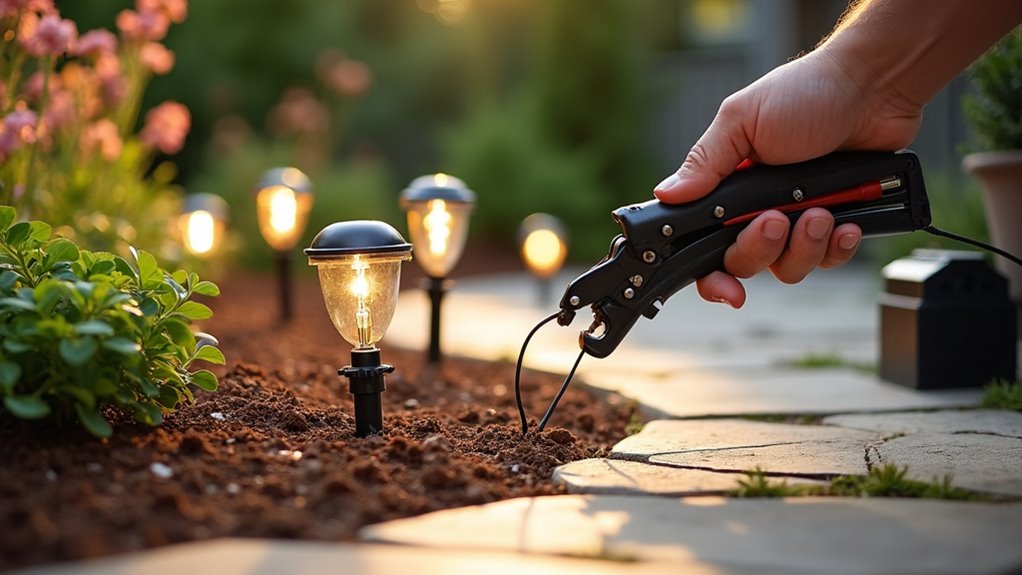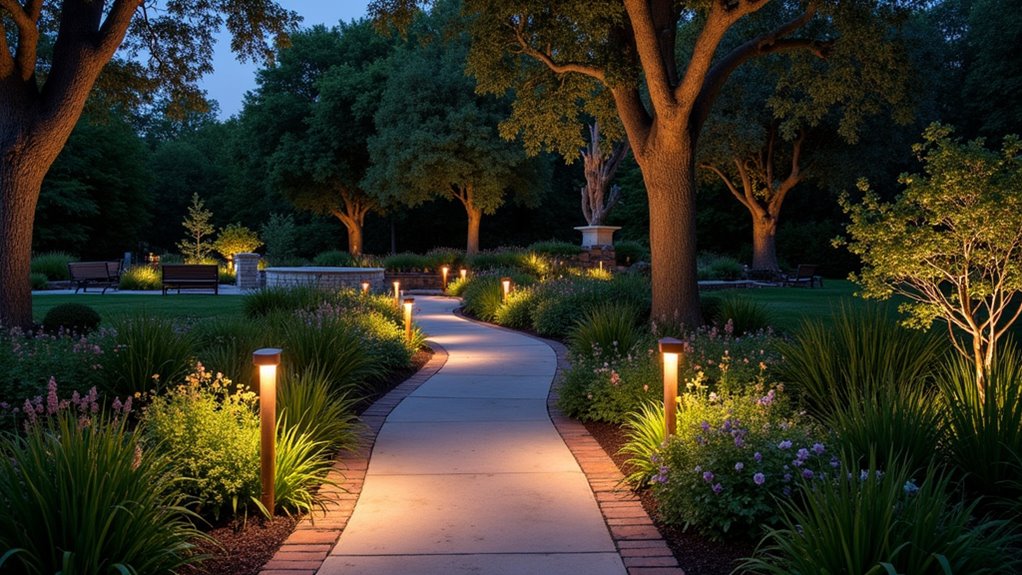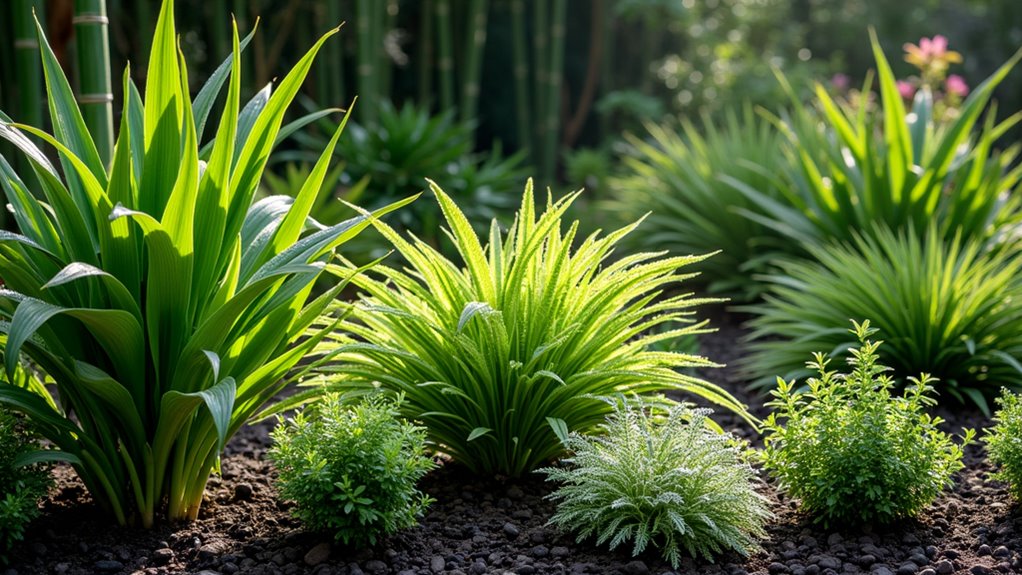Seven standout plants will transform your softscape with minimal upkeep: drought-resistant lavender for Mediterranean charm, swaying ornamental grasses for year-round movement, spreading sedum for ground coverage, Russian sage for silver-blue vertical interest, creeping thyme for pathway softening, Black-eyed Susan for pollinator attraction, and structured boxwood for evergreen foundation. You’ll enhance visual impact while minimizing maintenance hours with these proven performers. Uncover how these versatile selections can revolutionize your scenery design.
Lavender: A Drought-Resistant Mediterranean Beauty

Despite its delicate appearance, lavender (Lavandula spp.) thrives in challenging Mediterranean conditions, making it an ideal choice for xeriscaping and low-maintenance gardens.
You’ll find multiple lavender varieties that suit different design needs: English lavender (L. angustifolia) offers compact growth perfect for borders, while Spanish lavender (L. stoechas) creates striking vertical accents with its distinctive flower spikes. The lavender benefits extend beyond aesthetics – its silver-gray foliage provides year-round structure, while its fragrant blooms attract pollinators and repel deer.
Plant lavender in well-draining soil with full sun exposure. Space plants 18-24 inches apart for peak air circulation, and incorporate gravel mulch to reduce moisture retention. Once established, you’ll only need to prune spent blooms and shape the plant annually to maintain its architectural form.
Native Ornamental Grasses for Effortless Movement

Native ornamental grasses will transform your environment into a dynamic composition with their graceful plumes and seed heads moving in response to the slightest breeze. You’ll appreciate how these architectural plants maintain visual appeal through all four seasons, shifting from fresh spring growth to summer flowering, dramatic fall colors, and distinctive winter silhouettes. Their deep root systems make them exceptionally drought-tolerant, allowing you to create striking textural contrasts and movement in water-wise garden designs.
Swaying in the Breeze
When you’re seeking to add dynamic visual interest to your scenery, ornamental grasses deliver dramatic movement with minimal maintenance requirements. You’ll find that native varieties like Little Bluestem and Switchgrass respond instantly to even the slightest breeze, creating a mesmerizing dance across your surroundings.
Position these grasses strategically in areas where wind movement naturally occurs, such as along pathways or in open garden spaces. You can improve plant aesthetics by grouping different heights together tall Feather Reed Grass in the background with shorter Buffalo Grass in front. This layering technique amplifies the swaying effect while maintaining visual coherence. For best performance, plant your grasses where they’ll catch both morning and afternoon breezes, ensuring continuous motion that transforms your static environment into a kinetic display.
Year-Round Visual Interest
Although seasons change, ornamental grasses maintain their striking presence throughout the year’s cycles. You’ll find that native varieties offer exceptional seasonal color shifts, from spring’s vibrant greens to winter’s golden hues. These adaptable plants create texture contrast against hardscape elements and surrounding vegetation, enhancing your environment’s visual depth.
- Strategic placement of tall grass varieties like Miscanthus or Pennisetum creates dynamic screening effects while providing year-round structure
- Incorporating mixed heights of ornamental grasses establishes natural sight lines and focal points that persist through dormant periods
- Clustering different species with varied bloom times guarantees continuous visual interest, from summer’s feathery plumes to winter’s frost-covered seed heads
Select grasses that complement your site’s microclimates for peak performance and sustained aesthetic appeal.
Drought-Resistant Beauty
Selecting drought-resistant ornamental grasses lets you create dynamic, water-wise environments that sway gracefully in the breeze. Native varieties like Little Bluestem and Switchgrass demonstrate exceptional drought tolerance while providing year-round visual interest through their distinctive textures and forms.
You’ll optimize water conservation by clustering these grasses in dedicated zones, allowing their deep root systems to establish naturally. Position them strategically along slopes or in areas where traditional turf struggles. Their adaptability to poor soils and minimal irrigation requirements makes them ideal for sustainable terrain designs.
Consider incorporating Muhly Grass or Feather Reed Grass in masses to create stunning architectural elements. These specimens offer height variation and movement, transforming static spaces into living, breathing surroundings that thrive with minimal intervention.
Sedum: The Set-It-and-Forget-It Succulent
Sedum’s thick, succulent foliage creates a structural groundcover that thrives in rocky, nutrient-poor soils and drought conditions. You’ll find this versatile plant performing similarly well in both containers and garden areas, where its spreading habit forms dense mats that crowd out weeds while providing year-round visual interest. Its fleshy leaves shift from blue-green to burgundy as seasons change, culminating in late-summer blooms that attract pollinators and provide winter architectural interest through dried flower heads.
Sedum Growth and Care
When you’re looking for a virtually indestructible plant, Sedum emerges as a top choice among low-maintenance succulents. These hardy perennials thrive in both containers and ground cover applications, with sedum types ranging from low-growing stonecrop to upright cultivars. Sedum propagation occurs readily through stem cuttings or leaf division, making it cost-effective for large-scale softscape installations.
- Plant in well-draining soil with 6+ hours of sunlight, spacing 12-18 inches apart for ideal spread
- Trim back spent blooms in late fall to maintain shape and prevent self-seeding
- Water deeply but infrequently – once established, rainfall typically provides sufficient moisture
The plant’s drought-tolerant nature and adaptability to diverse soil conditions make it ideal for xeriscaping and sustainable garden designs. You’ll find sedums perform exceptionally well in USDA zones 3-10.
Sedum Design Applications
Because of their versatile growth habits, sedums create dynamic visual interest across multiple terrain layers. You’ll find tall upright sedum varieties perfect for back borders and focal points, while low-growing cultivars excel as groundcovers and rock garden specimens. Their drought-tolerant nature makes them ideal for green roofs and living walls.
Sedum benefits include year-round appeal through seasonal color changes, from spring’s emerging foliage to summer’s vibrant blooms and winter’s structural seedheads. You can mass them in contemporary designs for bold textural impact or integrate them into traditional gardens as transitional plants. They’re particularly effective in rain gardens, serving as moisture-control elements while adding architectural interest. Consider mixing different sedum varieties to create tapestries of color and form in difficult-to-maintain slopes or xeriscaping projects.
Russian Sage: A Silver-Blue Perennial Wonder
Despite its misleading name, Russian sage (Perovskia atriplicifolia) isn’t a true sage but rather a woody subshrub that’ll grace your surroundings with striking silver-blue spires from midsummer through fall. Its plant characteristics include drought-tolerant foliage, aromatic leaves, and upright architectural form that reaches 3-5 feet in height. You’ll find this perennial offers numerous garden benefits, from its deer resistance to its ability to thrive in poor soils.
- Position plants 24-36 inches apart in full sun locations where their silver foliage can create dramatic contrast against darker plantings
- Incorporate into xeriscaping designs as a structural anchor plant that requires minimal irrigation
- Utilize as a pollinator-attracting border along pathways or as a mass planting in Mediterranean-style gardens
Creeping Thyme: Ground Cover That Thrives on Neglect
As gardeners seek reliable ground cover options, creeping thyme (Thymus serpyllum) stands out as a versatile, low-growing perennial that forms dense 2-4 inch carpets of tiny, fragrant leaves.
You’ll find this Mediterranean native thrives in USDA zones 4-9, preferring well-drained soil and full sun. Ground cover benefits include erosion control on slopes, pathway softening, and weed suppression. Popular creeping thyme varieties like ‘Coccineus’ (red flowers), ‘Albus’ (white blooms), and ‘Pink Chintz’ (salmon-pink blossoms) offer design flexibility.
Plant it between pavers, along borders, or in rock gardens where foot traffic won’t damage it. You don’t need to mow or trim frequently – it maintains its compact shape naturally. During hot summers, it’ll release aromatic oils, creating a sensory experience in your garden setting.
Black-Eyed Susan: A Long-Blooming Prairie Favorite
While native prairie wildflowers often struggle in cultivated gardens, Black-eyed Susan (Rudbeckia hirta) proves to be an adaptable perennial that delivers months of vibrant yellow blooms from mid-summer through fall. You’ll find this hardy plant thrives in full sun locations with well-draining soil, requiring minimal irrigation once established.
- Position Black-eyed Susan in mass plantings or borders where its prolific pollinator attraction creates buzz-worthy habitat zones
- Pair with ideal companions like Purple Coneflower and Little Bluestem for an authentic prairie aesthetic that boosts biodiversity
- Cut spent blooms to extend flowering period and prevent aggressive self-seeding, though allowing some seed heads provides winter interest and bird forage
In zones 3-9, Black-eyed Susan’s upright form adds architectural interest while its drought tolerance makes it perfect for low-maintenance environments.
Boxwood: The Classic Low-Maintenance Evergreen
Boxwood (Buxus) stands as the quintessential evergreen choice for structured gardens, offering year-round foliage and exceptional flexibility in zones 5-8. You’ll find numerous boxwood varieties perfectly suited for hedges, topiaries, and foundation plantings, with common options including ‘Green Velvet’, ‘Winter Gem’, and ‘Green Mountain’.
| Variety | Height | Best Use |
|---|---|---|
| Green Velvet | 3-4′ | Formal hedges |
| Winter Gem | 4-6′ | Topiaries |
| Green Mountain | 5-7′ | Borders |
| Little Leaf | 2-3′ | Rock gardens |
| Justin Brouwers | 2-3′ | Container |
Boxwood pruning requirements remain minimal, needing only annual shaping to maintain desired form. These drought-tolerant shrubs thrive in well-draining soil and partial to full sun exposure. You’ll achieve ideal growth by spacing plants 2-3 feet apart and applying a slow-release fertilizer in spring.
Frequently Asked Questions
Can These Plants Coexist in the Same Garden Bed?
You’ll need to evaluate companion planting principles and growth compatibility before combining plants in a single bed. Consider each plant’s vertical spacing, root depth, and spreading patterns. It’s vital to analyze their water requirements, sunlight needs, and soil preferences. Properly spaced plants won’t compete for resources, and you can create distinct layers through strategic placement, ensuring your garden bed maintains visual interest and ecological balance.
How Often Should I Fertilize Low-Maintenance Plants?
You’ll need to apply slow-release fertilizer types just twice per year for most low-maintenance plants – once in early spring and again in mid-summer. For granular applications, you’re looking at a 3-4 month interval, while controlled-release options can last 6-8 months. Your soil’s nutrient content and drainage patterns will influence application frequency, so it’s worth conducting a soil test before establishing your fertilization schedule.
What’s the Best Time of Year to Plant These Species?
You’ll achieve ideal growth by implementing both spring planting and fall planting strategies, depending on your hardiness zone. Plant during early spring after the last frost for warm-season species, when soil temperatures reach 50°F. For cool-season varieties, initiate fall planting 6-8 weeks before initial frost, allowing root systems to establish before winter dormancy. This timing enhances root development and reduces transplant stress across your environment design.
Do Any of These Plants Attract Harmful Insects to Nearby Gardens?
You’ll find that properly selected low-maintenance plants actually help with pest control by attracting beneficial insects that prey on harmful insects. However, if you’re concerned about your garden’s ecosystem, maintain adequate spacing between plantings to promote air circulation and reduce pest-friendly conditions. Consider implementing companion planting strategies in your design layout, as certain plant combinations naturally deter unwanted pests while enhancing your scenery’s overall robustness.
Which Plants Work Best for Shaded Areas With Poor Drainage?
For challenging shaded areas with poor drainage, you’ll want to focus on shade loving plants that thrive in moist conditions. Consider incorporating Japanese Forest Grass (Hakonechloa) or Astilbe for their adaptability. To improve your site’s conditions, implement drainage solutions like raised beds or French drains before planting. You can also add Hostas or Ferns, as they’ll establish strong root systems even in poorly draining soil while creating dynamic textural interest.



